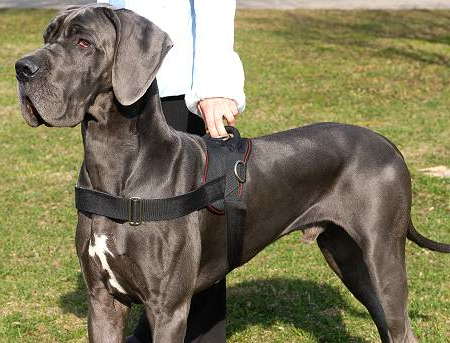You can train and control your dog using a variety of methods and techniques. What your want to train your dog to do or not to do can often determine what equipment you may need. Harnesses, halters, and collars are all used to control your dog during training or while you are out in public. It is up to you to decide which piece of equipment will work best for you and your pooch. To help you decide, consider the following brief explanations.
Understanding the use of a harness: For the average dog owner, harnesses are an alternative to collars. Unlike a collar, a harness distributes pressure across your dog’s body. It wraps around his torso, preventing choking and escape. The use of a harness requires a leash. Most often, collars are still worn with harnesses. As the popularity of dog fashion rises, many harnesses are made to match and fit with a variety of clothing.
If you are training your dog for a job, such as an assistance or sled dog, then you should use a harness. Harnesses encourage the dog to pull, especially breeds that are natural working dogs. For this reason, harnesses are often used in sight dog and sled dog training. If you are not training a working dog, then a harness may not be a good idea because of the tendency for your dog to pull. If you have a large dog, then a harness will may it near impossible to control your pooch. Often, harnesses are used with small dogs, although they still tend to pull.

Understanding the use of a halter: Halters are not alternatives to collars. Instead, they are used for training and control. A halter fits around your dog’s nose and neck. Unlike a muzzle, it does not prevent your dog from eating, barking, or biting. It does, however, allow you better control over your pooch. The use of a halter requires a leash. As you pull the halter, your dog’s nose is turned toward you, stopping the rest of his body. Because you are controlling the dog’s head and neck, you should never pull too long or too hard on the collar. Inappropriate use of the halter can injure your pooch.
Head halters are most often used with large dogs. Senior citizens and older children can control a dog with a head halter. The halters are also used in behavioral training. Walking your dog with a halter and teaching him to not venture too far ahead, chase cars, or eat feces are just three ways a halter can be used. When using a halter for training, the dog should be rewarded so that he understands the desired behavior.
Understanding the use of a collar: Collars are used for control and identification purposes; dog tags with contact and vaccination information are attached to the collar. All dogs should wear a collar for this purpose. If you want to walk your dog, then you will use his collar as a leash attachment. No matter what, a collar should never be too tight or uncomfortable to your pet. If your dog tries to pull on his leash, then a tight collar is a choking hazard.
Wait a minute!
You can take this promo code for a realy good deal
5VISPZLM -3%CLICK ON THE CODE TO COPY